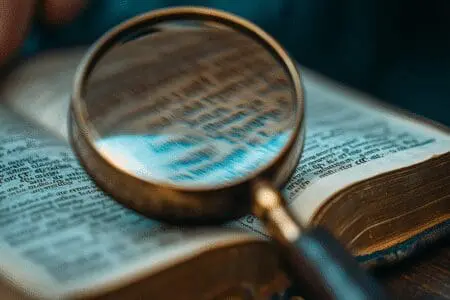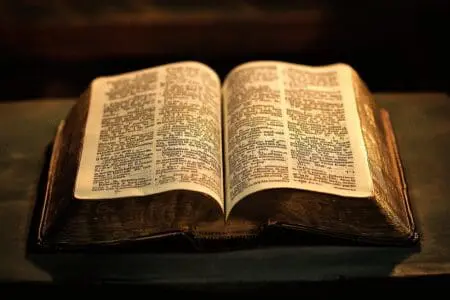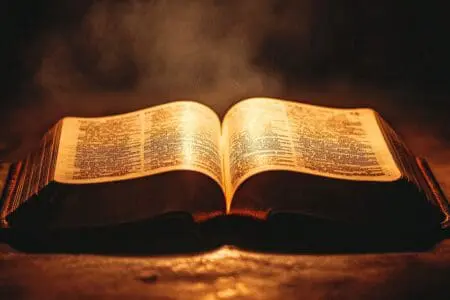I can still feel the weight of it. The huge family Bible in my hands back in Sunday school. It was ancient, enormous, and if I’m being honest, a little terrifying. “Turn to Haggai,” the teacher would say. My friends and I would start a frantic, rustling search through pages as thin as tissue paper, usually landing somewhere completely wrong, like the Psalms or maybe Leviticus. It felt like someone had handed me a thousand-piece puzzle with no picture on the box. That feeling isn’t unique. The question of how is the Bible organised isn’t just for scholars; it’s the first step to making sense of it all.
Without a map, you’re just wandering.
Think of this guide as that map. My goal isn’t to tell you what to believe. It’s just to show you how the pieces connect. We’re going to take a tour, walk down its hallways, and peek into its different rooms. By the time we’re done, you’ll see the surprisingly logical structure holding it all together. You’ll understand why it’s less a single book and more of a library, with every scroll and story having its own special place on the shelf.
More in Bible Category
What Is the First Word in the Bible
What Are the Longest Books in the Bible
How Many Bible Verses Are There in the Bible
Key Takeaways
- It’s a Library, Not a Single Book: The Bible is a collection of 66 individual books (in the Protestant canon) written by many authors over thousands of years.
- Two Main Sections: The entire collection is divided into two major parts: the Old Testament and the New Testament.
- Organisation is by Genre: The books are not arranged in chronological order. Instead, they are grouped by their literary type, such as history, poetry, prophecy, and letters.
- The Old Testament Lays the Foundation: It is organised into four main sections: the Pentateuch (Law), the Historical Books, the Poetic and Wisdom Books, and the Prophetic Books.
- The New Testament Builds on That Foundation: It also has four main sections: the Gospels, the Book of Acts (History), the Epistles (Letters), and the Book of Revelation (Prophecy).
- Understanding the Structure is Key: Knowing the layout transforms the Bible from an intimidating text into an accessible library, making it easier to read, study, and comprehend.
So, It’s Not Just One Big Book?
Here’s the first big secret: it’s not one book. That’s the most important thing to get your head around. The word “Bible” actually comes from the Greek word biblia, which means… “the books.” Plural. If you try to read it like a novel from page one to the end, you’re going to get very confused, very fast. It’d be like walking into a library, picking up the first book you see, and assuming it’s chapter one of a story that finishes with the very last book in the building. It just doesn’t work like that.
What you’re holding is an anthology. A library in miniature. It’s a curated collection of all kinds of writing. You’ll find sweeping historical accounts, beautiful poetry, detailed legal codes, personal letters, song lyrics, and prophetic visions. These were penned by over 40 different people from all walks of life—kings, shepherds, fishermen, prophets, doctors—over an incredible 1,500-year span.
The main dividing line in this library is between the Old Testament and the New Testament. The word “testament” is an older way of saying “covenant” or “agreement.” So, you have the story of the original covenant God made with his people, Israel, and the story of the new covenant made possible through Jesus Christ. Let’s push open the door to that first, bigger room: the Old Testament.
What’s the Big Deal About the Old Testament?
The Old Testament is the bedrock. It’s the foundation for everything that comes later. It spins the epic tale of creation, the dawn of humanity’s relationship with God, and the long, winding history of the nation of Israel. It contains 39 books (in the Protestant version), and this mini-library is also organised by genre into its own distinct wings.
Where Does It All Begin? The Pentateuch
The first five books you’ll encounter are known as the Pentateuch (a Greek name that means “five scrolls”) or the Torah (the Hebrew word for “the Law” or “instruction”). These are Genesis, Exodus, Leviticus, Numbers, and Deuteronomy. Within Judaism, these are the most sacred texts, and they really do set the stage for the entire Bible.
I remember as a kid just being baffled by the names. Genesis was fine, but Leviticus? Deuteronomy? They sounded like spells. Once you get what they’re for, though, it all makes sense. Genesis is the book of beginnings: the creation of the cosmos, the first people, and the stories of the patriarchs Abraham, Isaac, and Jacob. Exodus tells the dramatic story of the Israelites’ enslavement in Egypt and their stunning escape.
Then you have Leviticus, Numbers, and Deuteronomy. These books lay out the laws, rituals, and guidelines for how God’s people were meant to live. It’s a blend of community laws, moral principles, and religious ceremonies that shaped Israel’s identity. This is the constitution for the whole collection.
Is It Just a Bunch of History Lessons Next? The Historical Books
Once we move past the books of Law, we step into the Bible’s history section. This isn’t just a couple of books; it’s a twelve-volume collection that runs from Joshua all the way to Esther. The story picks right up where Deuteronomy concludes. These books trace the dramatic history of the nation of Israel. You get their arrival in the Promised Land, the soaring heights and crushing lows of their kingdoms, their cycles of loyalty and betrayal, and their eventual exile. It’s a rollercoaster.
- Getting Settled (and Unsettled): The book of Joshua covers the initial conquest of the land. But then Judges shows what happens next—a chaotic, repeating cycle of the people messing up, facing the consequences, and being rescued. The book of Ruth is a stunning short story tucked into this turbulent era.
- The Age of Kings: In 1 & 2 Samuel and 1 & 2 Kings, you see the rise of the monarchy. We meet legendary figures like King Saul, the heroic King David, and the wise King Solomon. These books chart the nation’s golden age, its tragic split into two kingdoms (Israel and Judah), and their eventual downfall and exile.
- Coming Home: The books of 1 & 2 Chronicles actually retell a lot of this history, but from a priest’s point of view, focusing on the temple. Then, Ezra, Nehemiah, and Esther tell the powerful story of the Jewish people returning from exile and starting the hard work of rebuilding their home and their hope.
But don’t mistake these for simple history textbooks. This is history with a purpose. Each story is told to show God’s presence and plan, even in the middle of humanity’s messy, complicated, and often heartbreaking drama.
Why Is There So Much Poetry in the Bible? The Wisdom and Poetic Books
Tucked right between Israel’s history and its future prophecies is a collection of writings that gets to the heart of what it means to be human. The five Wisdom and Poetic books—Job, Psalms, Proverbs, Ecclesiastes, and Song of Solomon—grapple with the big questions we still ask today about suffering, worship, love, and what life is all about.
Job is a powerful, poetic drama that wrestles with the age-old question of why good people have to suffer. The book of Psalms was basically Israel’s national songbook. It’s a collection of 150 songs and prayers that run the full gamut of human emotion, from pure joy to the depths of despair.
Proverbs is a treasure chest of wise sayings that offer practical, down-to-earth advice. Ecclesiastes takes a hard, philosophical look at the fleeting nature of life. And the Song of Solomon? It’s a beautiful, passionate poem celebrating romantic love. This section breathes soul into the Bible, giving a voice to the deeply personal side of faith.
Who Were These Prophets and Why Were They So Angry? The Prophetic Books
The last wing of the Old Testament library holds the writings of the prophets. Now, a prophet wasn’t a crystal-ball gazer. They were God’s messengers, sent to deliver urgent messages of warning, challenge, and hope to the people. This section used to throw me for a loop. The timeline felt all jumbled up. The big “aha!” moment came when I finally realized that these prophets weren’t writing after the fact; they were speaking during the events recorded in the Historical Books. Their work wasn’t an epilogue; it was live commentary.
This section is divided into two groups, based on length, not importance.
The Major Prophets refer to the five longer books: Isaiah, Jeremiah, Lamentations, Ezekiel, and Daniel. These men spoke to the people during the chaotic decades leading up to and during the nation’s exile. They delivered stark warnings about the consequences of injustice and idolatry, but they also painted incredible pictures of future hope and restoration.
The Minor Prophets are the 12 shorter books, from Hosea to Malachi. They might be shorter, but their words pack just as much punch. They tackle everything from God’s relentless love for his unfaithful people (Hosea) and a runaway prophet’s trip to a pagan city (Jonah) to fiery calls for social justice (Amos).
And What About the New Testament? What’s ‘New’ About It?
After Malachi’s final words, the line goes quiet for about 400 years. Then, the story roars back to life in the New Testament. There’s a dramatic shift in focus. The “new” here refers to the new covenant that Christians believe was launched through the life, death, and resurrection of Jesus. This collection of 27 books is much shorter than the Old Testament, but its global impact has been enormous. And just like the Old Testament, it’s arranged by the type of writing.
Why Are There Four Stories of the Same Life? The Gospels
The New Testament kicks off with the four Gospels: Matthew, Mark, Luke, and John. “Gospel” simply means “good news,” and all four tell the story of Jesus. But why four versions? I remember a friend explaining it over coffee once. He said, “It’s like having four witnesses to an incredible event. You wouldn’t want to hear from just one.” That clicked for me.
Each author wrote for a different community, with a unique focus, giving us a richer, fuller picture of Jesus.
- Matthew wrote mainly for a Jewish audience, constantly showing how Jesus fulfilled the Old Testament prophecies about the Messiah.
- Mark is the shortest, most breathless Gospel. He likely wrote for a Roman audience, presenting Jesus as a powerful, decisive man of action.
- Luke, who was a doctor and a careful historian, gives a detailed and compassionate account, highlighting Jesus’s care for the outcasts, the poor, and non-Jews.
- John is the most philosophical of the four, zeroing in on Jesus’s divine nature and his profound “I am” statements.
Read together, they offer a stunning, multi-dimensional portrait of the central figure of Christianity.
What Happened After Jesus Left? The Book of Acts
There’s only one history book in the New Testament: The Acts of the Apostles. It was written by Luke, making it a direct sequel to his Gospel. The story picks up right after Jesus ascends to heaven and tracks the explosive birth and growth of the early Christian church.
Acts is the indispensable bridge of the New Testament. It connects the life of Jesus in the Gospels to the letters of instruction that follow. We watch the message spread from a small group in Jerusalem “to the ends of the earth,” powered by the Holy Spirit and the work of apostles like Peter and Paul. It’s a high-stakes adventure of mission, miracles, and persecution that laid the groundwork for a global faith.
Who Wrote All Those Letters? The Epistles (or Letters)
The biggest chunk of the New Testament is made up of the Epistles—letters written by early church leaders to various churches and individuals. These letters unpack Christian beliefs, offer practical advice on how to live, and provide encouragement during tough times. They’re split into two main stacks.
First, you have the Pauline Epistles, the 13 letters from the Apostle Paul. They aren’t arranged by when they were written, but by size, from the longest (Romans) to the shortest (Philemon). Nine were sent to entire church communities (like those in Rome or Corinth) to tackle specific issues they were facing. The other four are called the Pastoral Epistles (1 & 2 Timothy, Titus, Philemon) because they are personal letters to church leaders with guidance and encouragement.
Next are the General Epistles. This is a batch of eight letters from other key figures like James (Jesus’s own brother), Peter, John, and Jude. They’re called “general” because they were written for a broader audience. They cover a whole range of important topics, from the relationship between faith and good deeds (James) to finding hope while suffering (1 Peter).
How Does It All End? The Book of Revelation
The Bible’s grand finale is the Book of Revelation, a work of apocalyptic prophecy written by the Apostle John. Let’s be honest: this is the weirdest and most argued-over book in the whole library. It’s filled with wild, symbolic visions of dragons, beasts, and heavenly battles that can leave your head spinning.
But its main goal wasn’t to be a secret decoder ring for the future. It was written to give incredible hope to first-century Christians who were facing brutal persecution. It paints a vivid picture of the ultimate triumph of Jesus over all evil and ends with a stunning vision of a new heaven and a new earth—a restored creation where God lives with his people. It’s a powerful and fitting capstone for the entire biblical story, bringing the narrative that started in a garden to a close in a perfect city.
But Is It All in Chronological Order?
This is a huge point of confusion, so let’s clear it up. Nope. The Bible is organised by literary type, not by a strict, linear timeline.
You really see this in the Old Testament. The prophet Jeremiah, for example, was active during the last days of Judah’s kingdom, events that are recorded in the book of 2 Kings. To really get what was going on, you almost need to read them side-by-side. The story of Job is set way back in an ancient, patriarchal era, maybe even before Abraham, yet his book is placed much later in the poetry section.
This isn’t a flaw; it’s a feature. Grouping the books this way lets you dive into one type of literature at a time. When you want to follow the historical narrative, you know where to turn. When you need comfort or wisdom, you can go straight to the Psalms or Proverbs. It makes the whole library much easier to navigate.
Does Every Bible Have the Same Books?
One last common question: are all Bibles identical? For the most part, yes, but there are some key differences. The official list of books considered to be inspired Scripture is called the “canon.” The Protestant canon has the 66 books that we’ve walked through here.
However, if you pick up a Roman Catholic or Eastern Orthodox Bible, you’ll find some additional books in the Old Testament. These are known as the Apocrypha or Deuterocanonical books. As scholars from places like Cambridge University explain, these were written in the 400-year gap between the Old and New Testaments. While they hold historical and religious value, different Christian traditions view their authority differently. This is why a Catholic Bible will be a bit thicker than the one you might find in a Baptist or Methodist church.
The Map in Your Hands
That massive, intimidating book that once seemed like a jumbled mess is actually a remarkably well-organised library. It’s a collection that guides you from creation and law in the Pentateuch, through the epic saga of a nation, into the raw, emotional heart of poetry and the challenging words of prophets. Then, you turn a corner into the New Testament to find four unique portraits of Jesus, an action-packed history of the early church, a stack of letters to guide it, and a final, breathtaking vision of hope.
Understanding this structure won’t answer all your questions, but it gives you the lay of the land. It gives you the library’s floor plan. It changes the daunting task of finding “Haggai” from a wild guess into a simple walk to the right section. The map is now in your hands. Happy exploring.
Frequently Asked Questions – How Is the Bible Organised

What practical advantage does understanding the Bible’s organisation provide to readers?
Knowing how the Bible is organised helps readers navigate the text more effectively, understand the type of writing they are reading, and interpret passages appropriately, making their reading more meaningful and less overwhelming.
How are the Gospels in the New Testament different from each other?
The four Gospels—Matthew, Mark, Luke, and John—each present a different perspective on Jesus’s life and teachings. They are written by different authors for different audiences, providing a comprehensive picture of who Jesus was.
Why are some prophets called Major Prophets and others Minor Prophets?
Prophets are called Major or Minor based on the length of their books, not their importance. The Major Prophets have longer books like Isaiah and Jeremiah, while the Minor Prophets have shorter books, such as Hosea and Malachi.
How are the books of the Old Testament organised?
The Old Testament books are organised by their genre or type of writing rather than chronological order. They are grouped into sections such as the Pentateuch (law books), historical books, poetry and wisdom books, and the writings of the prophets.
What are the two main sections of the Bible and what do they represent?
The two main sections of the Bible are the Old Testament and the New Testament. The Old Testament covers the story from creation up to the period before Jesus Christ, while the New Testament focuses on the life of Jesus, the early church, and the message of salvation.




